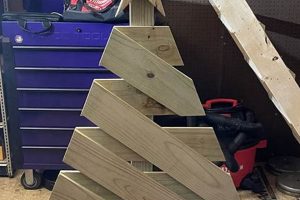The construction of a rustic barrier utilizing natural, repurposed limbs and boughs offers an economical and aesthetically distinct approach to property demarcation. This type of enclosure is typically assembled from readily available materials sourced directly from the landscape, transforming fallen or pruned branches into a functional perimeter.
Implementing a natural barrier presents several advantages, including cost savings, environmental sustainability through material reuse, and the creation of a unique visual character for residential or agricultural spaces. Historically, similar structures have been employed in rural settings as practical and easily constructed boundaries for livestock containment or garden protection, reflecting resourcefulness and harmony with the environment.
The following sections will detail the process of material selection, preparatory steps, construction techniques, and maintenance considerations crucial for successfully erecting a durable and visually appealing enclosure of this type.
Construction Considerations for a Natural Barrier
Effective implementation of a perimeter using repurposed limbs and boughs requires careful planning and execution. Adherence to the following guidelines will contribute to the longevity and structural integrity of the resulting enclosure.
Tip 1: Material Selection: Prioritize hardwoods like oak, maple, or hickory for increased resistance to decay. Avoid softwoods like pine or willow, as they decompose more rapidly, shortening the fence’s lifespan. Ensure branches are seasoned, not green, to minimize warping and cracking post-construction.
Tip 2: Foundation Stability: Establish a firm foundation by driving sturdy support posts deep into the ground. Consider using treated lumber or metal posts as anchors for the branch sections to enhance stability and prevent premature failure due to ground contact.
Tip 3: Interlocking Techniques: Employ secure interlocking methods such as weaving, lashing with durable cordage, or using galvanized wire to bind branches together. Properly secured intersections enhance the fence’s resistance to wind and impact.
Tip 4: Height and Spacing Consistency: Maintain uniform height and spacing between branches to create a visually appealing and structurally sound barrier. Inconsistent spacing can weaken the fence and detract from its aesthetic value.
Tip 5: Preservation and Treatment: Treat the finished structure with a non-toxic wood preservative to protect it from moisture, insects, and fungal decay. Reapply the preservative periodically to extend the fence’s lifespan.
Tip 6: Consider Local Regulations: Before commencing construction, verify local ordinances or homeowners’ association rules regarding fence height, materials, and setback requirements to avoid potential legal issues.
Tip 7: Drainage Considerations: Ensure adequate drainage around the base of the structure to prevent water accumulation, which can accelerate wood decay. Sloping the ground away from the fence or installing drainage channels can mitigate this risk.
Diligent application of these techniques results in a durable, aesthetically pleasing, and environmentally conscious boundary. The resulting structure offers an alternative to conventional fencing materials and enhances the natural character of the surrounding landscape.
The next section will address methods for maintaining the structure, along with potential design variations.
1. Material Selection
Material selection constitutes a foundational element in the creation of a durable and aesthetically pleasing structure using natural, repurposed branches. The type and condition of the branches directly impact the fence’s lifespan, structural integrity, and visual characteristics. Neglecting to select appropriate materials invariably leads to premature deterioration, structural failure, or an undesirable aesthetic outcome. For instance, utilizing green or unseasoned wood causes significant warping and cracking as the material dries, compromising the overall stability and appearance of the finished product.
Hardwood species, such as oak, maple, or hickory, offer superior resistance to decay and insect infestation compared to softwood varieties like pine or willow. This inherent resistance translates directly into a longer service life for the structure, reducing the need for frequent repairs or replacements. Furthermore, the diameter and straightness of the branches influence the ease of construction and the visual uniformity of the boundary. Selecting branches of consistent size and shape allows for more streamlined assembly and a more cohesive, visually appealing end result. Branches afflicted with rot, disease, or significant damage should be avoided entirely, as they represent points of weakness that compromise the entire structure.
In summation, the choice of material is not merely a superficial consideration but a critical determinant of the structure’s success. Prioritizing hardwoods, ensuring proper seasoning, and rejecting compromised materials are essential steps in maximizing the lifespan, structural soundness, and aesthetic value of a natural structure. Overlooking these aspects introduces significant risks and undermines the overall viability of the project.
2. Structural Integrity
The longevity and efficacy of a perimeter constructed from natural branches hinges directly on its structural integrity. The term refers to the ability of the barrier to withstand external forceswind, impact, ground movementwithout deformation or collapse. The primary cause of failure in these structures is inadequate attention to fundamental engineering principles during construction, resulting in a system vulnerable to environmental stressors. Consider, for instance, a barrier erected without properly secured joints; even a moderate gust of wind can exert sufficient force to dislodge branches, creating gaps and compromising the intended boundary. A similar effect occurs when improperly cured or decaying materials are used, decreasing branch strength and load-bearing capabilities.
Structural integrity is not merely an abstract concept but a tangible attribute achieved through specific construction practices. Deeply embedded support posts, for example, provide resistance against overturning forces, effectively anchoring the branch sections to the ground. Interlocking branch arrangements, such as weaving or lashing with durable cordage, distribute loads across multiple elements, preventing localized stress concentrations. Employing techniques like mortise-and-tenon joints, though labor-intensive, creates exceptionally strong connections capable of withstanding significant pressure. The absence of these measures invariably leads to a structure prone to failure, necessitating frequent repairs and ultimately shortening its useful lifespan. Observe instances where natural fences collapse after heavy rainfall or strong winds; these scenarios almost always reveal deficiencies in joint construction or inadequate foundation support.
In conclusion, structural integrity constitutes a non-negotiable element in the successful implementation of a barrier using natural branches. While the aesthetic appeal and environmental benefits are significant, they are rendered irrelevant if the structure lacks the capacity to perform its intended function reliably. Prioritizing sound engineering principles and employing robust construction techniques are therefore paramount. Challenges inherent in using irregular natural materials can be overcome through meticulous planning and execution, resulting in a durable and aesthetically pleasing boundary that harmonizes with the surrounding environment.
3. Aesthetic Integration
The visual harmony between a rustic barrier and its environment constitutes a key determinant of its overall success. Aesthetic integration, in the context of a constructed from natural branches, refers to the seamless blending of the structure’s visual characteristics with the surrounding landscape. Failure to achieve this integration results in a jarring and unnatural appearance, detracting from the property’s overall value and visual appeal. The color, texture, and arrangement of the branches, alongside the fence’s height and alignment, directly influence its perceived relationship with its surroundings. For example, a starkly geometric fence constructed from brightly colored, mismatched branches can clash significantly with a natural woodland setting. In contrast, a fence utilizing naturally weathered, locally sourced branches arranged in an organic pattern seamlessly blends into a similar environment.
Practical applications of aesthetic integration principles involve careful consideration of site context and material selection. Prior to construction, assessing the dominant colors, textures, and forms present in the landscape is crucial. This assessment informs the choice of branch species, treatment methods, and construction techniques. For instance, if the surrounding vegetation features predominantly muted earth tones and rough textures, utilizing branches with similar characteristics helps to create a cohesive visual effect. Similarly, aligning the fence’s contours with the natural topography can further enhance its integration. Consider the impact of direct sunlight on the structure’s appearance; a fence strategically placed to cast interesting shadows can add visual depth and interest without disrupting the overall harmony. Furthermore, allowing climbing plants to naturally grow along the barrier further softens its edges and promotes its seamless integration into the landscape.
In conclusion, aesthetic integration is not merely a cosmetic consideration but a fundamental aspect of implementing a barrier constructed from natural branches. Achieving this integration requires a holistic approach, encompassing careful material selection, thoughtful design, and a deep understanding of the surrounding environment. Challenges inherent in working with irregular, natural materials can be overcome through mindful planning and a commitment to creating a boundary that enhances, rather than detracts from, the inherent beauty of the landscape. Overlooking this element can lead to a visually discordant structure, undermining the project’s overall goals and potentially diminishing the property’s aesthetic value.
4. Cost-effectiveness
The economic advantage of erecting a barrier using natural materials derives primarily from reduced material expenditures. Traditional fencing options, such as wood planks, metal panels, or vinyl composites, entail substantial upfront costs for materials, often necessitating professional installation, adding significantly to the overall project expense. Constructing a boundary from repurposed tree limbs, conversely, leverages resources already present on or near the property, minimizing or eliminating the need for purchased materials. The primary expense then becomes labor, which can be managed through self-construction, further reducing the financial outlay. Consider, for instance, a rural landowner with access to forested areas; the raw materials for a significant length of fencing may be available without monetary cost, translating to considerable savings compared to purchasing manufactured fencing products. The practical significance of this cost-effectiveness lies in enabling property owners with limited budgets to effectively demarcate their land, contain livestock, or enhance privacy without incurring significant debt.
However, the long-term cost-effectiveness of a natural branch barrier must also factor in maintenance requirements and potential replacement costs. While the initial investment is low, the lifespan of a fence constructed from untreated natural materials is generally shorter than that of professionally installed fences made from durable, manufactured products. Regular maintenance, including the replacement of decaying branches and reinforcement of weakened sections, is essential to prolong the fence’s lifespan and preserve its functionality. Treating the branches with a wood preservative can mitigate decay but introduces an additional expense. A cost-benefit analysis should therefore compare the low initial cost and recurring maintenance expenses of a natural fence against the higher initial cost and lower long-term maintenance of conventional fencing options. Instances exist where the long-term costs of maintaining a natural fence outweigh the initial savings, particularly in regions with harsh climates or significant pest infestations.
In summary, the cost-effectiveness of using natural branches for constructing a barrier represents a key benefit, primarily due to the reduced or eliminated material costs. This advantage is particularly relevant for property owners seeking economical solutions for property demarcation or containment. However, a comprehensive assessment of long-term maintenance requirements, potential replacement costs, and the durability of chosen materials is crucial to accurately determine the overall economic viability of this approach. While the initial savings are often significant, neglecting to account for the life cycle costs can undermine the perceived economic advantages over time. Therefore, a balanced perspective, considering both short-term and long-term financial implications, is essential for making an informed decision.
5. Environmental Impact
The environmental implications of constructing a boundary using natural branches represent a significant consideration, influencing resource utilization, waste generation, and ecological disruption. The selection of materials, construction methods, and long-term maintenance practices directly affect the magnitude and nature of the environmental footprint. A thorough understanding of these impacts enables informed decision-making and promotes sustainable building practices.
- Reduced Demand for Manufactured Materials
Utilizing repurposed limbs and boughs diminishes the need for industrially produced fencing materials such as treated lumber, metal, or vinyl. The manufacturing processes associated with these alternatives consume significant energy, generate greenhouse gas emissions, and contribute to resource depletion. By opting for natural branches, the reliance on these environmentally intensive processes is lessened, promoting a more sustainable approach to property demarcation.
- Waste Stream Diversion
Transforming fallen or pruned branches into a functional fence diverts organic waste from landfills or incineration facilities. Decomposition in landfills produces methane, a potent greenhouse gas, while incineration releases harmful pollutants into the atmosphere. Reusing these materials as fencing reduces the volume of waste requiring disposal, mitigating these negative environmental consequences. This practice aligns with the principles of waste reduction and resource conservation, contributing to a more circular economy.
- Habitat Preservation
Responsible sourcing practices are crucial to minimize the impact on local ecosystems. Avoiding the indiscriminate felling of live trees and prioritizing the use of fallen or pruned branches helps to preserve natural habitats and maintain biodiversity. Sustainable forestry practices ensure the long-term health and resilience of forests, preventing deforestation and habitat fragmentation. Furthermore, the completed barrier can provide habitat and shelter for small animals and insects, enhancing the ecological value of the landscape.
- Carbon Sequestration
While the construction process itself may involve some carbon emissions related to transportation and processing, the wood used in the fence represents stored carbon dioxide captured from the atmosphere during the tree’s growth. By utilizing this wood in a long-lasting structure, the carbon remains sequestered, mitigating the effects of climate change. Furthermore, the presence of the fence may encourage the growth of additional vegetation, further enhancing carbon sequestration capabilities within the surrounding ecosystem.
In conclusion, the construction of a using natural branches offers several environmental benefits compared to conventional fencing methods. Reduced demand for manufactured materials, waste stream diversion, habitat preservation, and carbon sequestration all contribute to a lower environmental impact. However, responsible sourcing practices, sustainable construction techniques, and diligent maintenance are essential to maximize these benefits and ensure the long-term ecological viability of this approach.
Frequently Asked Questions
The following questions address common concerns and misconceptions regarding the construction and maintenance of enclosures crafted from natural branches.
Question 1: What is the anticipated lifespan of a structure crafted from natural branches?
The lifespan of a natural branch barrier varies significantly depending on the type of wood used, the climate, and the level of maintenance provided. Hardwoods, such as oak or hickory, generally exhibit greater resistance to decay and can last for several years. However, consistent exposure to moisture and pests can accelerate deterioration. Regular inspection and timely repairs are essential for maximizing longevity. Expect a lifespan ranging from 5 to 15 years, assuming appropriate materials and maintenance.
Question 2: Are there any specific branch types that should be avoided?
Softwoods, such as pine or willow, should be avoided due to their susceptibility to rot and insect infestation. Green or unseasoned branches are also unsuitable, as they tend to warp and crack as they dry, compromising the fence’s structural integrity. Branches exhibiting signs of decay, disease, or significant damage should be discarded. Prioritize the selection of mature, seasoned hardwoods free from visible defects.
Question 3: What is the most effective method for securing branches together?
Several methods can be employed to secure branches, each offering varying degrees of strength and durability. Lashing with durable cordage, such as nylon rope or wire, provides a flexible yet robust connection. Weaving branches together creates a visually appealing and structurally sound network. For more permanent connections, consider using galvanized nails or screws, ensuring they are properly countersunk to prevent corrosion. The optimal method depends on the desired aesthetic and the anticipated stress on the structure.
Question 4: Is it necessary to treat the wood to prevent decay?
While not strictly necessary, treating the wood with a preservative significantly extends the lifespan of the structure. Non-toxic, environmentally friendly wood preservatives are recommended to minimize potential harm to plants and animals. Apply the preservative according to the manufacturer’s instructions, ensuring thorough coverage of all exposed surfaces. Regular reapplication is necessary to maintain the preservative’s effectiveness.
Question 5: Are there any legal restrictions regarding fence height or placement?
Local ordinances and homeowners’ association rules often regulate fence height, setback requirements, and permitted materials. It is crucial to consult with local authorities and review relevant regulations prior to commencing construction to ensure compliance and avoid potential legal issues. Failure to adhere to these regulations may result in fines or the requirement to remove the structure.
Question 6: How can the barrier be maintained to ensure its long-term stability and aesthetic appeal?
Regular inspection is paramount. Replace any decaying or damaged branches promptly. Tighten or replace any loose lashings or fasteners. Trim any encroaching vegetation that may compromise the structure’s integrity. Reapply wood preservative as needed. Consistent maintenance is essential for preserving the fence’s functionality and visual characteristics.
These questions provide a foundational understanding of key considerations in natural branch barrier construction. Diligent planning and execution contribute to a durable and aesthetically pleasing outcome.
The following section details design variations and advanced construction techniques.
Concluding Assessment of Natural Branch Barrier Construction
The preceding exploration of the principles and practices associated with a diy tree branch fence underscores its multifaceted nature. Material selection, structural integrity, aesthetic integration, cost-effectiveness, and environmental impact all represent critical considerations that demand careful attention. The creation of a durable, visually appealing, and ecologically sound boundary necessitates a thorough understanding of these factors and the application of appropriate construction techniques.
The erection of a diy tree branch fence is not merely an exercise in resourcefulness; it represents a conscious choice to engage with the surrounding environment in a sustainable and aesthetically meaningful way. Prospective builders are encouraged to approach this endeavor with diligence, informed by a commitment to sound engineering principles and a deep appreciation for the natural world. The resulting structure, when thoughtfully designed and meticulously constructed, will serve as a testament to both human ingenuity and ecological stewardship.







